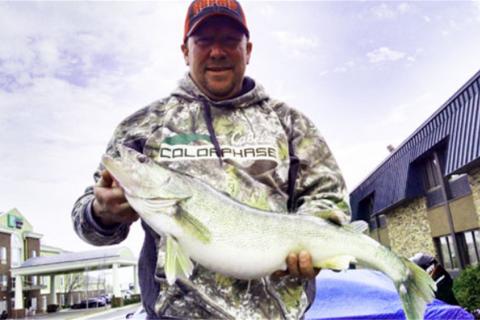
By Jeff Samsei
Cabela’s Field Staff team member Dave Schmidt shares his proven techniques.
Walleye pro Dave Schmidt commonly uses fishing flies to get the attention of spring walleyes, but no fly rods factor into the equation.
The flies, which are typically bucktail streamers tied on No. 2 or 4 hooks, are instead cast or pulled with spinning or baitcasting tackle and delivered close to the bottom with three-way rigs.
“It’s an extremely effective way to catch fish during the spring,” said Schmidt, a Cabela’s Field Staff team member who lives in Oshkosh, Wis.
Whether cast or pulled behind the boat, the flies offer subtle motion and mimic baitfish. Typical presentations are very slow, especially during early spring.
Schmidt likes flies for river walleye fishing from March through the end of June, and targets fish moving upriver to spawn and downriver after the spawn.
Pulling the fly rigs allows Schmidt to search for fish, but that is considered trolling, which isn’t legal in all states. Additionally, casting allows for more targeted presentations when the walleyes are in known locations.
For pulling flies, Schmidt uses a 6½-foot medium or medium light baitcasting rod, a reel with a flipping button so he can easily release line, and 10-pound-test braid, which allows Schmidt to feel everything.
He seeks to keep the line at a 45-degree angle and the weight ticking bottom all the time, and moves the boat at a snail’s pace.
When a fish bites, he sets the hook with a gentle sweep.
For casting applications, he prefers spinning gear and monofilament.
Often he’ll cast 90 degrees to the current, let the rig sink to the bottom, and work the rig with short snaps and drops until the rig is directly downstream. No hookset typically is needed with that presentation.
Either way, Schmidt looks for current breaks caused by wing dams and other obstructions and focuses presentations on the seams between currents and eddies.
“Working right on the edges is very important,” he said.
Other important aspects include keeping the rig on the bottom and experimenting with specific offerings to find out what the fish want any given day. Schmidt uses a variety of fly colors, and always likes to have several tied and handy so he can make regular changes until the walleyes start biting.
Schmidt also experiments with tipping bait, and if he is fishing with someone else, they typically begin with one angler fishing a plain fly and the other fishing one that is tipped with a minnow.
“Sometimes they want a small profile and really prefer a fly with nothing else on it,” Schmidt said. “Other times they want that bigger profile and you want the biggest minnow you can find.”
Depending on the laws in the state where he is fishing, Schmidt might tie two or even three flies on his leader.
The leader length ranges from about 4 to 10 feet with the shortest leaders used in the strongest current.
- 5484 views

